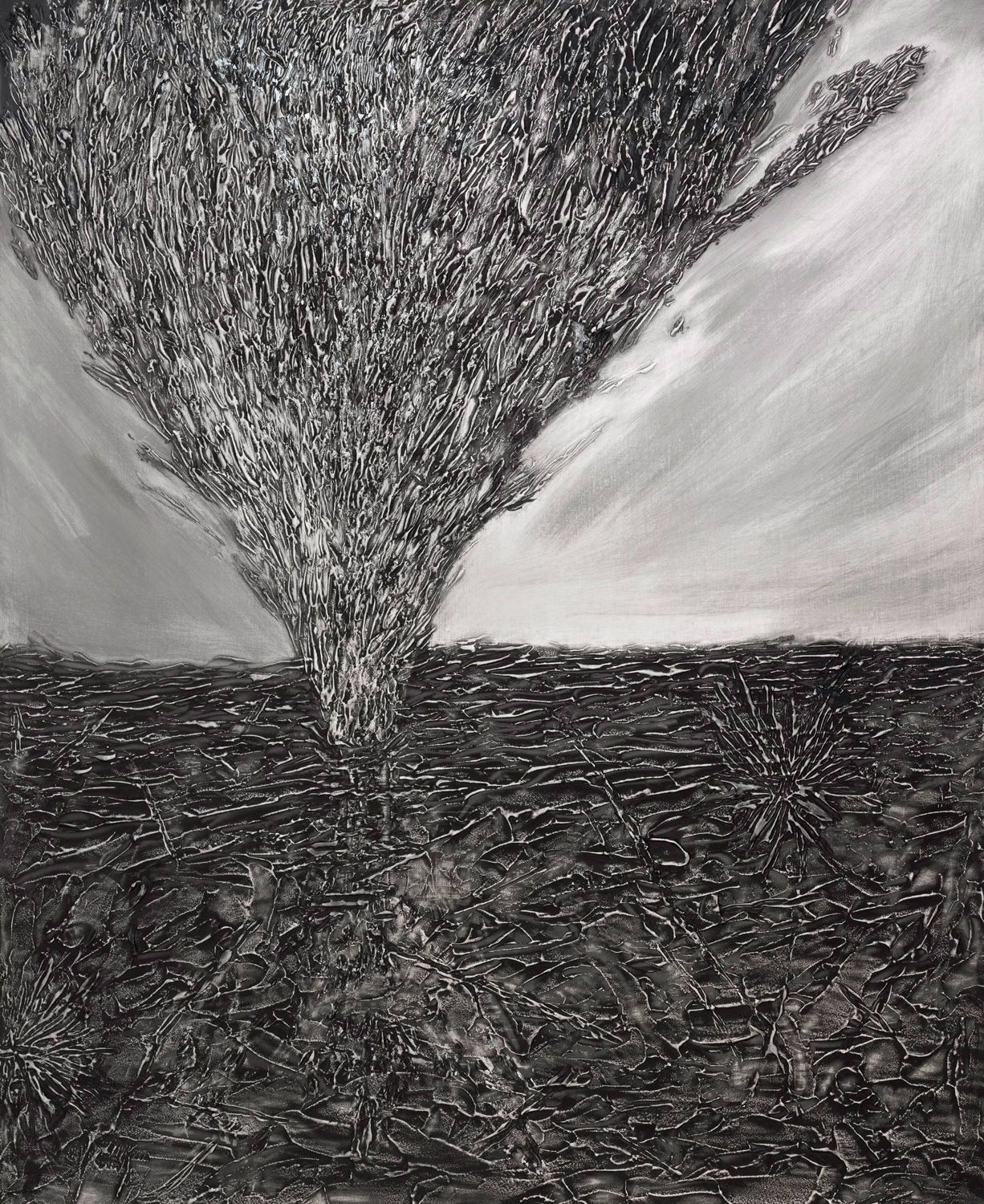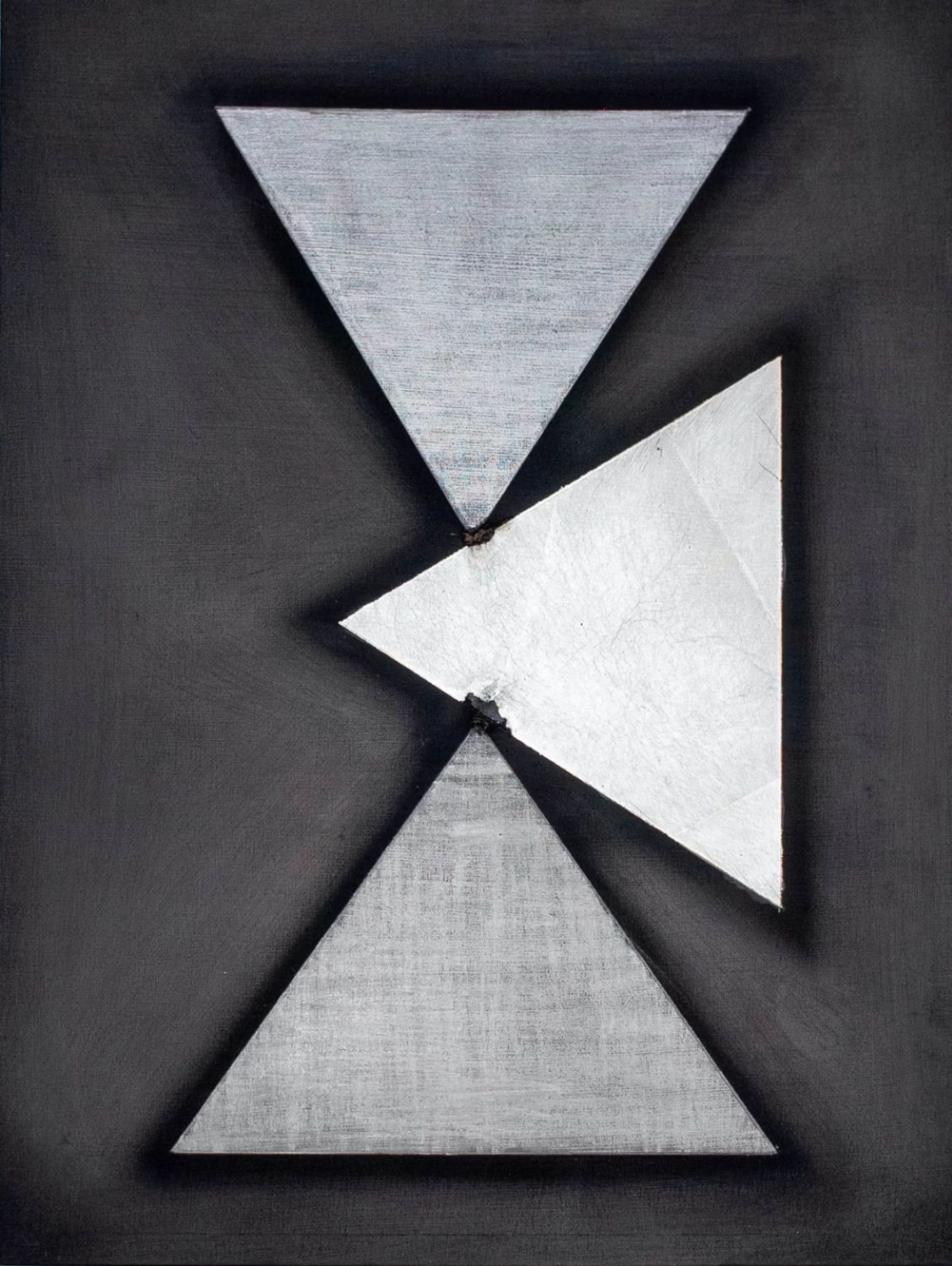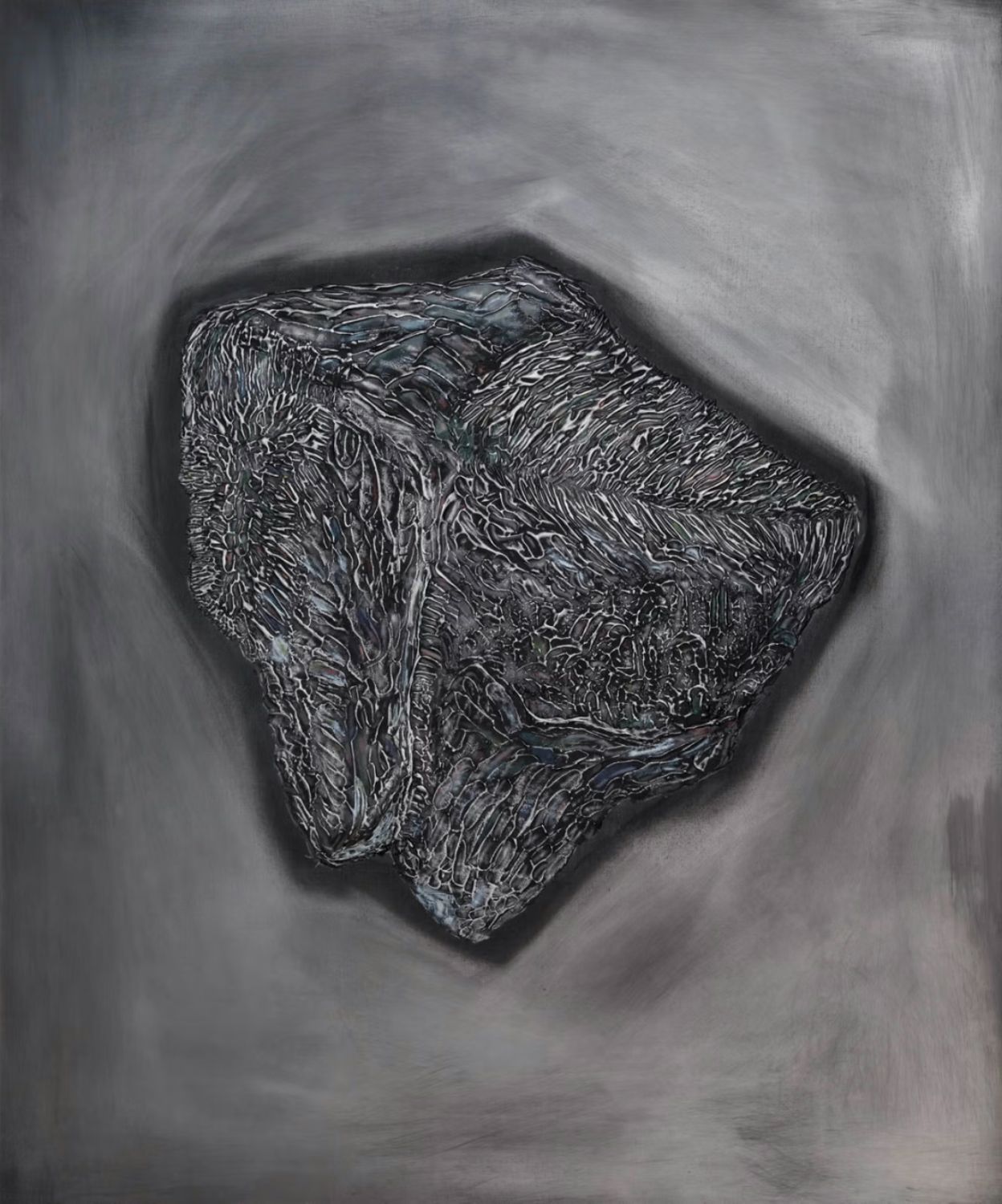
The Burning Surface: David Goldes’ vision expands in 'Dearest Earth, Darkest Sky'
Published January 30th, 2025 by Scott Melamed
In a solo exhibition at Dreamsong, the artist moves beyond cameras and currents to explore darkness through more tactile media
Banner image: David Goldes, From Sky to Earth (detail), 2024. Graphite, molding paste, black gesso on paper. 27 x 23 in. All images courtesy of Dreamsong.
For three decades, David Goldes produced photographs using elemental materials such as water, air pressure, magnetism, wind, and, since at least 2014, electricity. These were staged experiments, what he called "performing still lifes." For 2023's Unpredictable, Goldes left photography behind and created a series of drawings, with electricity as an element in the creation process. Thousands of volts were sent through the stark pieces, changing them, creating surprising shapes and relations — graphite and silver leaf in the works serving as the conductive agent.
In his latest show, Dearest Earth, Darkest Sky, on view at Dreamsong through March 1, Goldes continues exploring imagery beyond photography. And, for the first time in many years, electricity has left center stage.
The ten new works of the show are a significant achievement for Goldes, demonstrating a surreal vision of desolation, loss, and the scars of violence. With a masterful display of restraint and mystery, eight of the works are landscapes and all share a tonal and material sensibility: dark, searching grays, twisting biomorphic shapes, shining in places and matte in others. The works are all on paper of a similar size, each composed of graphite, acrylic, and molding paste.
Goldes’ sense of composition is extraordinary. His skies are a fine balance of light and dark, with several of the works sharing a common horizon line, each faintly aglow from a distant unseen source. The land fields are made of the manipulated molding paste layered with paint and graphite, reading in places like scarring, suggestions of past events, past wounding. Goldes spoke to me about one of the landscapes. As with the others, Stain is primarily graytone divided between sky and earth. What distinguishes it is a single blood-colored mark. “That stain started much bigger,” he recalls. “I would come in and think, no it’s too big, what do you need that for, it’s too obvious. Slowly it gets smaller and smaller and smaller. It still may be too big.”
I allow some silence. He continues, “Or maybe it has something to do with time. That the stain was more overt when it first was made, but like memory itself, is distortive. I was probably battling with my sense of what is seen and what is remembered. It was getting smaller because I was forgetting, or did I need…” He trails off, before saying: “I think I might even want to make it smaller yet, I’ll bring some black paint over.”
 David Goldes, Stain, 2024. Graphite, acrylic, molding paste, black gesso on paper. 27 x 23".
David Goldes, Stain, 2024. Graphite, acrylic, molding paste, black gesso on paper. 27 x 23".
Adjacent to Stain in the front room is the keystone piece, Earth Memory. A geyser bursts from the landscape and fills most of the sky in a triangle shape reminiscent of the geometric bodies in his previous solo show at the gallery. This bursting form could be water, or it could be an explosion of flame, or possibly even a rush of plantlife rising from the earth. The rupture and chaos of Goldes' early experiments in electricity — pages scorched with flame, fire shooting out of the tip of a Ticonderoga pencil — come to mind.
One landscape is a water scene. In The Sea Is, the viewer is placed low looking up, the horizon line high, as the sea churns below a dark sky. Sparse, subtle flecks of gold and brown aid in the water's reflective glow, spiraling beneath a hidden halo in the clouds. The overall tone of the show is so muted, so controlled, that the moments of hinted-at drama risk being missed (for the better, I think). I sense Goldes’ heart in this tension between the bursting ruptures, the violent breaks in image, and the muted, restrained interplay of light and darkness.

 Top: David Goldes, Earth Memory, 2024. Graphite, molding paste, black gesso on paper. 27 x 23". Bottom: David Goldes, Ag-C #21, 2019. Graphite, silver leaf, and black gesso on paper, 16,000 volts 12 x 8.875". From the exhibition Unpredictable, 2023.
Top: David Goldes, Earth Memory, 2024. Graphite, molding paste, black gesso on paper. 27 x 23". Bottom: David Goldes, Ag-C #21, 2019. Graphite, silver leaf, and black gesso on paper, 16,000 volts 12 x 8.875". From the exhibition Unpredictable, 2023.
Goldes first brought electricity into his work to create surprise through rupture and combustion. This creation of “an unknown action" animated the kind of wonder and playfulness he has always sought in his work. Flames and near destruction. And while electricity was just the latest elementary material Goldes chose to explore, it was also a kind of homecoming. He speaks of having created his own crystal radio as a young child, humming in perfect-pitch the morse code letters of street signs in Brooklyn in middle school, and, with a friend, testing his mettle via self-shocking from a wall outlet.
Though electricity brought an urgent, violent immediacy to his practice of performing still lifes, the pieces were still photographs in the end, which meant they retained a certain cool distance. Goldes likes to cite Roland Barthes from the book Camera Lucida here, stating that photographs are always of something that happened in the past. "Also, they have no surface or evidence of the hand, the person who made them," Goldes adds. If the appeal of electricity and open circuits was vivification — a scintillated awakening — photography added some remove.
With his latest work, both within 2023's Unpredictable and here in Dearest Earth, Darkest Sky, we meet Goldes in the burning present. The sky of From Sky to Earth is pure black over smudge-gray earth. In one of the two moments of electricity-induced burning in the show, a rupture line runs down the middle, the page torn open — a wounding, and a connection to Goldes’ previous work. Nearby, in Comet Fragment Passing, the crossing comet mirrors the line of the rip.
 At left: David Goldes, Stain, 2024. Graphite, acrylic, molding paste, black gesso on paper. 27 x 23". At right: Telling Surfaces, 2024. Graphite, molding paste, black gesso on paper. 27 x 23"
At left: David Goldes, Stain, 2024. Graphite, acrylic, molding paste, black gesso on paper. 27 x 23". At right: Telling Surfaces, 2024. Graphite, molding paste, black gesso on paper. 27 x 23"
"The world has gone further off its orbit," Goldes says. "And presumably will go even further. There were some very pressing world events and imagery. There is one image that is a direct reference of bombardment in Gaza. There were just these flat holes in the earth. That’s what happens when you drop a bomb on a flat landscape, it generates a circle. It is destructive in all dimensions. That imagery is somewhat disappearing, Gaza, Ukraine, Sudan, less seen even though it is no less horrifying. I was interested in bringing that kind of information into another form that might stay with us — half imaginative, half a reference."
You cannot control what happens with a living expression of electricity. This was the main idea behind Goldes’ multi-year exploration of the natural phenomenon, performed by creating circuits with intentional gaps where currents would leap across and occasionally combust his still lifes. With this new work, leaving photography and (for the most part) electricity behind, Goldes has begun a new kind of open circuit for himself. On one side sits the work; on the other, hopefully, a public open to receiving it. "One of the great things about art-making is there’s a component of it that has its own mind," he tells me. "It wants to go where it wants to go."
When an artist tries something new, there may be no one there on the other side of the circuit, no guaranteed response. But they introduce into the world something that can go missing for so long that people forget what it looks like: courage. It might be of a limited kind, existing entirely on the field of a particular work of art, unable to leap any further than to the individuals who see the work. By exploring new vistas decades into an accomplished career, in Dearest Earth, Darkest Sky Goldes has performed such an act. By my lights, the current takes. ◼︎
 David Goldes, From Above, 2024. Graphite, acrylic, molding paste, black gesso on paper. 27 x 23"
David Goldes, From Above, 2024. Graphite, acrylic, molding paste, black gesso on paper. 27 x 23"
Dearest Earth, Darkest Sky is on view at Dreamsong through March 1. To see more, visit the gallery's website or follow them on Instagram @dreamsong.art.
To see more of David Goldes' work, visit his website or follow him on Instagram @david_goldes.
We can't do it without you.
Help keep independent arts journalism alive in the Twin Cities.